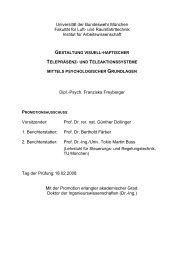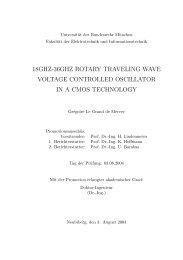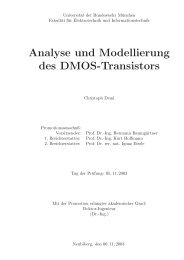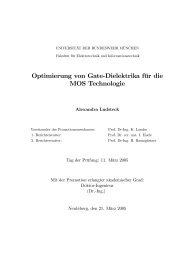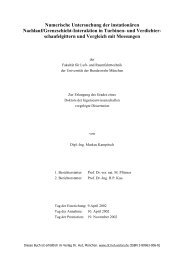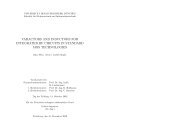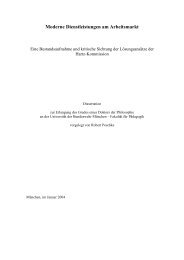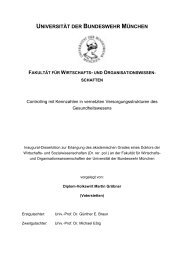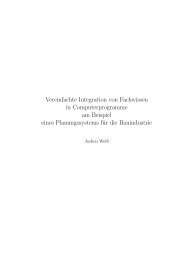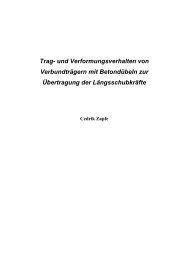Precise Orbit Determination of Global Navigation Satellite System of ...
Precise Orbit Determination of Global Navigation Satellite System of ...
Precise Orbit Determination of Global Navigation Satellite System of ...
You also want an ePaper? Increase the reach of your titles
YUMPU automatically turns print PDFs into web optimized ePapers that Google loves.
Chapter 5 Perturbation Models <strong>of</strong> IGSO,GEO and MEO <strong>Satellite</strong>s <strong>Orbit</strong>s<br />
Difference (meter)<br />
3500<br />
2500<br />
1500<br />
500<br />
-500<br />
-1500<br />
-2500<br />
-3500<br />
dx<br />
dy<br />
dz<br />
0 24 48 72 96 120<br />
Tim e (hour)<br />
144 168 192 216 240<br />
5.4 Other Perturbations<br />
Figure 5-30 Effect <strong>of</strong> the Solar Radiation on Inclined Geostationary <strong>Satellite</strong><br />
Other important perturbations such as ocean tide, solid earth tide, permanent tide, station displacement due to<br />
Pole tide and solid earth tide, ocean loading and so on have very small influences on IGSO and GEO satellites<br />
compared to the perturbations discussed above, but to MEO satellite (like GPS) some <strong>of</strong> these perturbations may<br />
be considered.<br />
5.4.1 Solid Earth Tides<br />
Actually the earth can be considered as the elastic one, the attraction <strong>of</strong> the Sun and Moon on the earth will cause<br />
the earth mass to respond periodically by deforming and thus changing the earth’s geopotential and displacing<br />
the tracking station positions. This phenomenon is called solid earth tides. According to McCarthy (1992), solid<br />
earth tides are most easily modeled as variations in the standard geopotential coefficients Cnm and Snm , and can<br />
be calculated by two steps. First step uses a frequency independent Love number κ 2 (assuming κ 2 = 03 . ) and an<br />
evaluation <strong>of</strong> the tidal potential in the time domain from a lunar and solar ephemeris. The changes in normalized<br />
second degree geopotential coefficients for this step can be describes as follows<br />
1 R GM j<br />
∆C20<br />
= κ 2<br />
P<br />
3 20 (sin φ j )<br />
(5-42)<br />
5 GM r<br />
3 3<br />
e<br />
� ⊕ j=<br />
2<br />
3 3<br />
e<br />
� ⊕ j=<br />
2<br />
j<br />
1 3 R GM j<br />
∆C21<br />
= κ 2<br />
P<br />
3 21(sinφ<br />
j ) cos λ j<br />
(5-43)<br />
3 5 GM r<br />
3 3<br />
e<br />
� ⊕ j=<br />
2<br />
j<br />
1 3 R GM j<br />
∆S<br />
21 = κ 2<br />
P<br />
3 21(sin<br />
φ j ) sin λ j<br />
(5-44)<br />
3 5 GM r<br />
3 3<br />
e<br />
� ⊕ j=<br />
2<br />
j<br />
1 12 R GM j<br />
∆C22<br />
= κ 2<br />
P<br />
3 22 (sin φ j ) cos λ j<br />
(5-45)<br />
12 5 GM r<br />
3 3<br />
e<br />
� ⊕ j=<br />
2<br />
j<br />
1 12 R GM j<br />
∆S<br />
22 = κ 2<br />
P<br />
3 22 (sin φ j ) sin λ j<br />
(5-46)<br />
12 5 GM r<br />
where<br />
κ 2<br />
Re GM ⊕<br />
GM j<br />
j<br />
nominal second degree Love number<br />
equatorial radius <strong>of</strong> the Earth<br />
gravitational parameter for the Earth<br />
gravitational parameter for the Moon (j=2) and Sun (j=3)<br />
62



